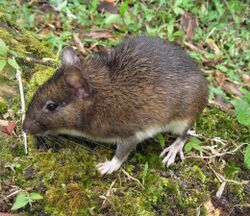Biology:Euryzygomatomyinae
| Euryzygomatomyinae | |
|---|---|

| |
| Trinomys, a member of the subfamily Euryzygomatomyinae. | |
| Scientific classification | |
| Domain: | Eukaryota |
| Kingdom: | Animalia |
| Phylum: | Chordata |
| Class: | Mammalia |
| Order: | Rodentia |
| Parvorder: | Caviomorpha |
| Superfamily: | Octodontoidea |
| Family: | Echimyidae |
| Subfamily: | Euryzygomatomyinae Fabre et al. 2017 [1] |
| Genera | |
|
Clyomys | |
Euryzygomatinae is a subfamily of rodents, proposed in 2017, and containing three extant genera of spiny Echimyidae: Clyomys, Euryzygomatomys, and Trinomys.[1]
Members of this echimyid subfamily all share an origin in the eastern part of Brazil, close to the Atlantic Forest.
Morpho-anatomy
The teeth of Euryzygomatomyines are characterized by several features:
- elongate lower and upper incisor roots ;
- five lophids on the lower deciduous premolars 4 ;
- either four lophids in Trinomys, or three lophids in Clyomys and Euryzygomatomys, on the lower molars 1 ;
- well-connected lophs on the cheek teeth ;
- three molar roots anchoring the upper molars.
Their zygomatic arch is reduced with a slightly concave dorsal margin, and the jugal bone is ventrally expanded with much reduced, scarcely salient inferior process.[1]
Molecular signatures
At the protein level, one amino acid replacement from leucine to proline yields a shared derived character state that is diagnostic for defining the Euryzygomatomyinae: the amino-acid proline at position homologous to site 294 of the human GHR.[2]
Phylogeny
Within Euryzygomatomyinae, Clyomys is the sister group to Euryzygomatomys. In turn, these two fossorial genera are the sister group to the terrestrial Trinomys.
In the phylogeny of the family Echimyidae, Euryzygomatomyinae is the sister group to a large assemblage comprising Carterodon and the family Capromyidae.[1] These phylogenetic relationships, based on the comparison of complete mitochondrial DNA genomes and nuclear DNA exons, disagree with analyses of craniodental characters which cluster together the fossorial genera Clyomys, Euryzygomatomys and Carterodon.[3][4]
| Genus-level cladogram of the Euryzygomatomyinae with their relation to Carterodon and Capromyidae. |
| This cladogram has been reconstructed from mitochondrial and nuclear DNA characters.[5][6][7][8][9][1] According to this phylogenetic tree, the fossorial genera Euryzygomatomys, Clyomys, and Carterodon constitute a polyphyletic assemblage (red bar). |
References
- ↑ 1.0 1.1 1.2 1.3 1.4 Fabre, Pierre-Henri; Upham, Nathan S.; Emmons, Louise H.; Justy, Fabienne; Leite, Yuri L. R.; Loss, Ana Carolina; Orlando, Ludovic; Tilak, Marie-Ka et al. (2017-03-01). "Mitogenomic Phylogeny, Diversification, and Biogeography of South American Spiny Rats". Molecular Biology and Evolution 34 (3): 613–633. doi:10.1093/molbev/msw261. ISSN 0737-4038. PMID 28025278.
- ↑ Growth Hormone Receptor (GHR) protein: NCBI accession AAI36497.1
- ↑ Carvalho, Guilherme A. S.; Salles, Leandro O. (2004-12-01). "Relationships among extant and fossil echimyids (Rodentia: Hystricognathi)". Zoological Journal of the Linnean Society 142 (4): 445–477. doi:10.1111/j.1096-3642.2004.00150.x. ISSN 0024-4082.
- ↑ Candela, Adriana M.; Rasia, Luciano L. (2012-02-01). "Tooth morphology of Echimyidae (Rodentia, Caviomorpha): homology assessments, fossils, and evolution". Zoological Journal of the Linnean Society 164 (2): 451–480. doi:10.1111/j.1096-3642.2011.00762.x. ISSN 0024-4082.
- ↑ Galewski, Thomas; Mauffrey, Jean-François; Leite, Yuri L. R.; Patton, James L.; Douzery, Emmanuel J. P. (2005). "Ecomorphological diversification among South American spiny rats (Rodentia; Echimyidae): a phylogenetic and chronological approach". Molecular Phylogenetics and Evolution 34 (3): 601–615. doi:10.1016/j.ympev.2004.11.015. PMID 15683932.
- ↑ Upham, Nathan S.; Patterson, Bruce D. (2012). "Diversification and biogeography of the Neotropical caviomorph lineage Octodontoidea (Rodentia: Hystricognathi)". Molecular Phylogenetics and Evolution 63 (2): 417–429. doi:10.1016/j.ympev.2012.01.020. PMID 22327013.
- ↑ Fabre, Pierre-Henri; Galewski, Thomas; Tilak, Marie-ka; Douzery, Emmanuel J. P. (2013-03-01). "Diversification of South American spiny rats (Echimyidae): a multigene phylogenetic approach" (in en). Zoologica Scripta 42 (2): 117–134. doi:10.1111/j.1463-6409.2012.00572.x. ISSN 1463-6409.
- ↑ Fabre, Pierre-Henri; Vilstrup, Julia T.; Raghavan, Maanasa; Der Sarkissian, Clio; Willerslev, Eske; Douzery, Emmanuel J. P.; Orlando, Ludovic (2014-07-01). "Rodents of the Caribbean: origin and diversification of hutias unravelled by next-generation museomics" (in en). Biology Letters 10 (7): 20140266. doi:10.1098/rsbl.2014.0266. ISSN 1744-9561. PMID 25115033.
- ↑ Upham, Nathan S.; Patterson, Bruce D. (2015). "Evolution of Caviomorph rodents: a complete phylogeny and timetree for living genera". Biology of caviomorph rodents: diversity and evolution. Buenos Aires: SAREM Series A, Mammalogical Research — Sociedad Argentina para el Estudio de los Mamíferos. pp. 63–120.
Wikidata ☰ Q48837034 entry
 |

